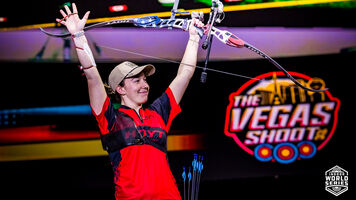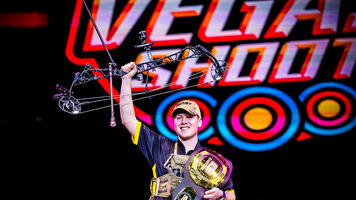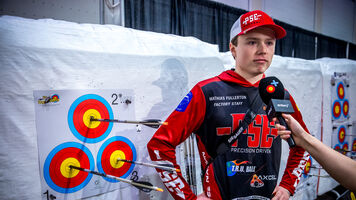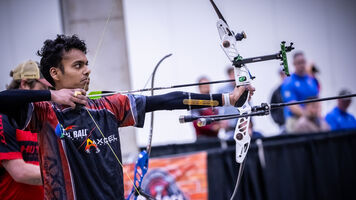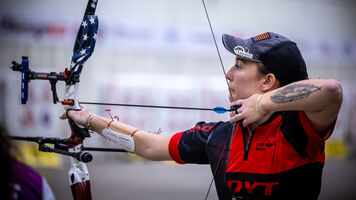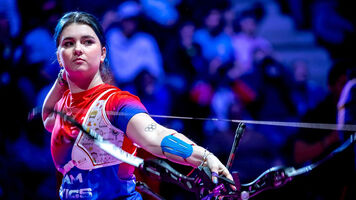The nine challenges every field archer has to beat
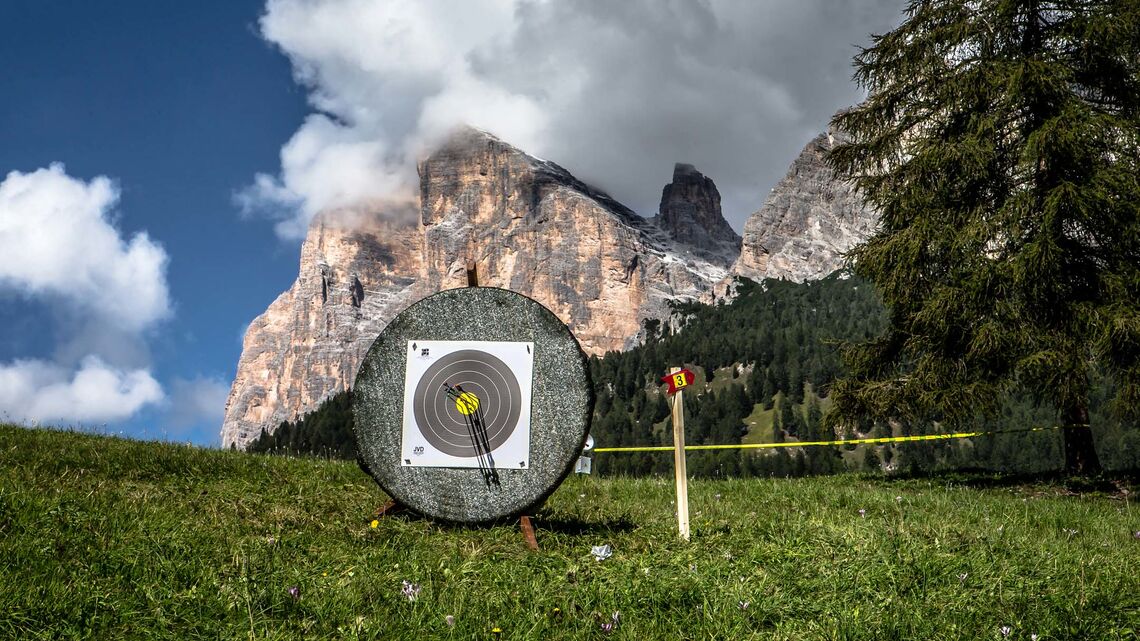
Field archery is not only a discipline of accuracy but one that requires an understanding of changing terrain and conditions, technique and equipment.
Shooting targets of varying size and distance requires an any to acquire additional skills – with an eye on ultimately mastering the field course.
Against the breathtaking backdrop of the Alps in Italy, competitors at the 2018 World Archery Field Championships in Cortina dealt with the ski slopes’ tricky angles, gruelling physical layout and weather ranging from sunshine to rain.
Every target on a field course counts and, while some might not realise it, every experienced field archer goes through a routine that assesses how they’ll approach each shot.
It sounds difficult, but field archery is both incredibly fun and very rewarding. Especially when you’re prepared – and know these nine challenges you’ll need to deal with when you step out onto the course.
1. Shooting position
“The biggest thing you are going to feel [compared to target archery] is different footing because you are not on flat ground; you have roots, grass or mud that will make you put your feet together,” said Matthew Requa.
Most US archers favour keeping their feet close on uneven ground, but Frenchman JC Valladont is renowned for choosing a much wider stance.
It is, like most things in archery, personal preference. The key is to find a stable base from which to execute the shot – and that might mean making use of rocks, nearby foliage or digging a ledge into the hill with your boots, as Sander Dolderman suggests.
2. Target and distance
The unmarked portion of World Archery field courses has four different-sized targets set at distances between set minimums and maximums. The first challenge is working out which size target face is being used, and the second is choosing a sightmark.
Techniques for identifying the target size include comparing the diameter to the arrow holes already in place – if they look small it’s larger, big and it’s smaller – or using the size of the boss, but that can be deceiving.
Distance judging is another whole article in itself (coming soon, too), but most athletes use a combination of gut instinct, counting smaller portions across the ground and adding those up, and comparing the size of the target to the view through their scope or sight.
“What I do is to tell myself that it doesn’t matter where my sight is, I will still need a good shot if I want to know if my sightmark is right,” said Linda Ochoa-Anderson.

3. cut
Counter-intuitively for newer field archers, both uphill and downhill slopes will shorten the effective distance of a target. That’s because gravity affects the flight of the arrow in a different way when compared to shooting on the flat ground.
When shooting downhill, gravity works with the arrow to keep it flying faster for longer; uphill, the speed of the arrow is working more directly against the force of gravity, meaning it doesn’t arc (or dip) as much.
Most archers will reduce the effective distance of the target more for a downhill shot than they will for an uphill shot – but the exact amounts will be particular to bowstyle, equipment and technique.
As an example, most compound archers had to shoot that 60-metre uphill target that finished the Cortina finals on a sightmark of around 54 metres.
4. Angle
Even when the sightmark is correct, getting the correct body angle is still a challenge.
“I’m always checking that my position, which is like a ‘T’, is correct so that I can move my hips correctly,” said 2018 World Archery Field Champion Lisa Unruh.
Most shooters try to bend from the hips in order to keep the shape of the top half of their bodies identical from target to target. That’s not always possible at extreme angles and more unusual positions will introduce muscle tension that affects how the arrow flies.
Compound and recurve archers find this easier to deal with because both have draw check mechanisms, namely the wall on a compound bow and the clicker on a recurve, that ensure the string is drawn the same distance no matter the angle.
For barebow archers, who have neither of those checks, it’s a different story – and maintaining proper upper-body posture is all-the-more important.

5. Cross-slope
“Find something in the background that’s straight, up and down, and then cant your bow so that it appears that it’s straight [in comparison]. This will help you with the angles and avoid left or right issues,” said Requa.
Canting – or tilting the bow – can be a problem on the flat, but when you’ve got cross-slopes going left-to-right and right-to-left, and even an unstable base, it’s difficult to know which way is up.
Just a small tilt can cause an arrow to veer dramatically off horizontally so, aside from a compound archer’s bubble, trees are a field archer’s best friend. They normally grow straight upwards and are the best reference against which to compare the top limb, to ensure there’s no unwanted angle on the bow.
Strangely, even when there’s no cant and the bow angle is correct, it can feel unnatural because of body position or terrain.
6. Light
Not only does the level of light change the eye’s perception, so it can have an impact on distance judging and assessing the target, but the contrast between light and shadow can make aiming difficult – especially for compound archers.
“The sight of the peepsight changes,” explained Dolderman, especially if the hole in the peep is too small. “It can be difficult to see through without light.”
A lot of compound archers choose either a peepsight with a larger aperture or a less-magnified scope that they would shoot on the target range, or both.

7. Execute
With all of these things going on, a field archer still has to deliver a good shot.
“There’s so much to do, but you’ve got to aim well and you got to execute well,” said 2016 World Archery Field Champion Steve Anderson.
“There’s a big difference between shooting practice and getting onto the field, understanding the dynamics of shooting downhill and uphill, and how your aim is going to work when you’re doing it.”
Understanding only comes with experience.
8. Reflect
Even more crucial than shooting a good shot is an archer’s own assessment of it.
So many decisions, plus the quality of execution, affect where the arrow lands that this honest questioning of the process taken is critical to making the target a success.
Was it a good shot? Was it aimed in the right place? Did I make the correct distance judgement or angle cut?
“Make sure your first arrow is your best arrow, so you can adjust from that one. If the first one is not good, then hope your second one is or at least have an idea where it’s going to hit,” said barebow archer John Demmer III.
Whether a target goes well or badly, a good field archer will learn from it – how the bow is performing, if cuts or sight marks are correct and where the arrows are landing – and take that with them to the next target on the course.
9. Weather, stamina and consistency
On top of all the field archery-specific challenges, there’s also the conditions – which, by the way, are much more difficult to deal with when compared to a target range.
There’s unlikely to be anyone carrying around a tent, so using the cover provided by trees, protecting and drying equipment and keeping things out of the mud all becomes much tricker.
Every field course is different. Some are flat, some are much harder to walk around.
The six-plus-kilometre 24-target loops in Cortina were not easy. At over 1500 metres of elevation above sea level and with thin air, the slopes were an orienteering contest more than a casual walk. The effect of a raised heart rate that results from a brisk hike up the side of a mountain shouldn’t be underestimated when it comes to shooting a good arrow.
“It’s really long days out there and the courses are tough, so I think mentally staying in the game the whole time is very important,” said Paige Pearce.
“It’s really easy to let your mind wander on some targets and drop some unnecessary points, so you really have to be mentally strong whether it’s raining, windy or the hill is bad footing.”
So what’s the pay-off for going head-to-head with all the challenges on a field course?
It’s the satisfaction of getting a target right.
The 2018 World Archery Field Championships took place in Cortina, Italy on 4-9 September.






